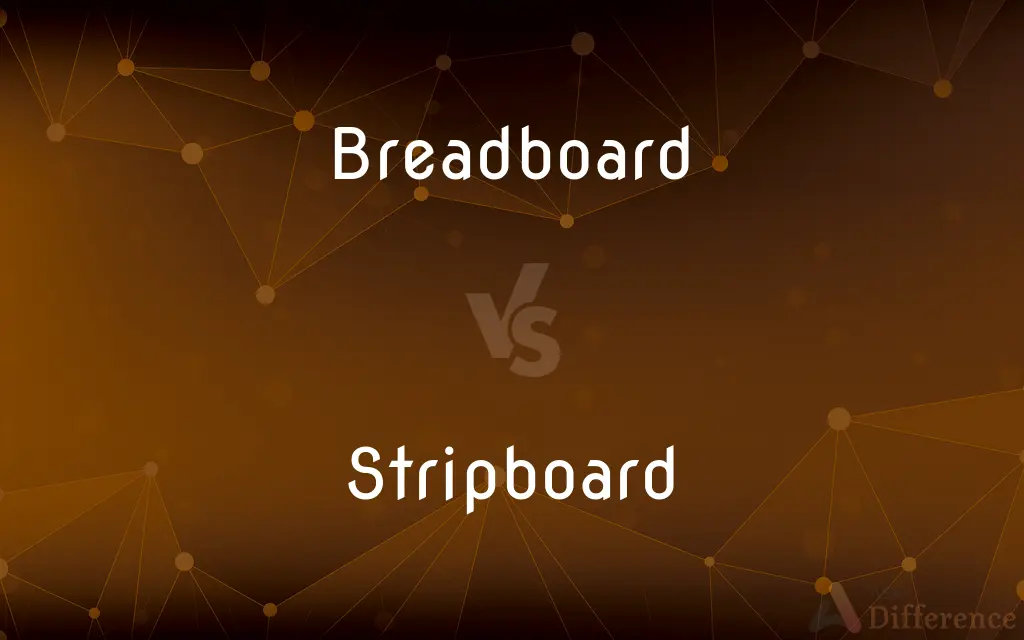Breadboard vs. Stripboard — What's the Difference?
By Fiza Rafique & Maham Liaqat — Updated on April 27, 2024
Breadboards are reusable platforms for temporary electronics projects, allowing easy component insertion without soldering, while stripboards have permanently soldered connections for more durable builds.

Difference Between Breadboard and Stripboard
Table of Contents
ADVERTISEMENT
Key Differences
A breadboard is primarily used for prototyping electronic circuits without the need for soldering; components are inserted into a grid of holes with underlying metal strips that create temporary connections. Whereas, stripboard consists of rows of copper strips running underneath holes where components are inserted and then soldered to form permanent connections.
Breadboards offer the flexibility to easily change and adjust components, making them ideal for testing and modifying circuit designs quickly. On the other hand, stripboards are suited for creating more permanent and robust circuit layouts once the design is finalized.
The non-permanent nature of breadboards means they are not suitable for applications where a durable or long-term circuit is needed. Conversely, stripboards, with their soldered connections, provide a more stable and lasting electronic circuit.
Breadboards are typically made of a plastic body with lots of holes aligned in rows, linked internally by metal connectors. In contrast, stripboards are made of a non-conductive material like phenolic or fiberglass with copper strips that must be soldered.
While breadboards are great for beginners and educational purposes due to their ease of use and reversibility, stripboards require more skill in soldering and circuit planning, making them better suited for advanced users and permanent projects.
ADVERTISEMENT
Comparison Chart
Connection Type
Temporary, no soldering required
Permanent, requires soldering
Material
Plastic body with metal strips
Phenolic or fiberglass with copper strips
Usability
Ideal for testing and modification
Best for finalizing and permanent setups
Skill Level
Beginner-friendly
Requires soldering skills
Durability
Less durable, not suitable for long-term use
More durable, designed for permanent circuits
Compare with Definitions
Breadboard
A board for making an experimental model of an electric circuit.
He assembled the prototype on a breadboard to test his new circuit design.
Stripboard
Requires components to be soldered for connection.
She soldered the transistor onto the stripboard to secure it.
Breadboard
Reusable and does not require soldering.
She appreciated the breadboard for its reusability in multiple projects.
Stripboard
Often used by hobbyists for durable electronics projects.
He preferred using a stripboard for projects that needed to withstand regular handling.
Breadboard
Ideal for educational and prototyping purposes.
The electronics workshop used breadboards extensively for demonstration.
Stripboard
Used for more permanent and stable circuit builds.
For the final project, the circuit was transferred from a breadboard to a stripboard.
Breadboard
Comprises a series of interconnected holes for inserting components.
He inserted resistors and capacitors into the breadboard to form the circuit.
Stripboard
Not suitable for frequent changes once soldered.
Once components are soldered onto a stripboard, modifications are difficult.
Breadboard
A platform for temporary circuit construction and testing.
Students used a breadboard to quickly swap components during the lab.
Stripboard
A type of electronics prototyping board with pre-drilled holes and copper strips.
He designed a permanent amplifier circuit on a stripboard.
Breadboard
A breadboard, or protoboard, is a construction base for prototyping of electronics. Originally the word referred to a literal bread board, a polished piece of wood used when slicing bread.
Stripboard
Stripboard is the generic name for a widely used type of electronics prototyping board characterized by a 0.1 inches (2.54 mm) regular (rectangular) grid of holes, with wide parallel strips of copper cladding running in one direction all the way across one side of the board. It is commonly also known by the name of the original product Veroboard, which is a trademark, in the UK, of British company Vero Technologies Ltd and Canadian company Pixel Print Ltd.
Breadboard
A board on which bread is sliced or dough is kneaded.
Stripboard
A type of prototyping board characterized by a ⅒″ regular rectangular grid of holes, with wide parallel strips of copper cladding running in one direction all the way across one side of the board.
Breadboard
An experimental model, especially of an electric circuit; a prototype.
Stripboard
A piece of given dimensions of such a prototyping board.
Breadboard
A thin, blank, often white board on which a prototype circuit with numerous connections for circuit elements is constructed.
Breadboard
To construct an experimental model of (an electric circuit, for example).
Breadboard
A cutting board, especially for cutting bread.
Breadboard
A pull-out cutting board underneath a counter, found in many kitchens.
Breadboard
(electronics) A device used to build a (usually temporary) prototype of an electronic circuit and for experimenting with circuit designs. Both solder and solderless versions are available; the solderless type are easily reusable.
Breadboard
(transitive) To set up (an electronic device) on a breadboard.
Breadboard
A wooden or plastic board on which dough is kneaded or bread is sliced
Common Curiosities
What is the main use of a breadboard in electronics?
It is used for prototyping and testing electronic circuits without permanent soldering.
Can components on a breadboard be reused?
Yes, components can be easily removed and reused in different projects.
What is the primary advantage of using a stripboard?
It provides a more durable and permanent connection for electronic circuits.
How do you connect components on a stripboard?
Components are inserted into holes and soldered to the copper strips to create permanent connections.
Can a stripboard be modified after soldering?
Modifications are possible but challenging due to the need to desolder components.
Which is better for beginners in electronics, breadboard or stripboard?
Breadboards are better for beginners due to their ease of use and flexibility.
How do you prevent short circuits on a stripboard?
Careful planning and isolation of copper strips are required to prevent short circuits.
What tools are needed for working with a stripboard?
A soldering iron, solder, and sometimes a drill or cutter to modify the copper strips.
Are there size limitations for breadboards and stripboards?
Both come in various sizes, but the layout must be considered to fit the project needs.
How long can a circuit remain on a breadboard?
It can remain as long as needed for testing but is not suitable for permanent use.
Is a breadboard suitable for long-term electronic projects?
No, breadboards are intended for temporary setups and prototyping.
Are stripboards more expensive than breadboards?
Typically, stripboards can be more costly due to the materials and the process needed for permanent setups.
Can breadboards handle high-frequency circuits?
Breadboards can be used but are not ideal for high-frequency circuits due to potential connectivity issues.
Can you use a breadboard for a final product?
It is not recommended as breadboards are intended for prototyping and may not offer reliable long-term connections.
What materials are breadboards and stripboards made of?
Breadboards are typically made of plastic with metal connections, while stripboards are made of a non-conductive base with copper strips.
Share Your Discovery

Previous Comparison
Nightclub vs. Casino
Next Comparison
Audacious vs. BoldAuthor Spotlight
Written by
Fiza RafiqueFiza Rafique is a skilled content writer at AskDifference.com, where she meticulously refines and enhances written pieces. Drawing from her vast editorial expertise, Fiza ensures clarity, accuracy, and precision in every article. Passionate about language, she continually seeks to elevate the quality of content for readers worldwide.
Co-written by
Maham Liaqat













































